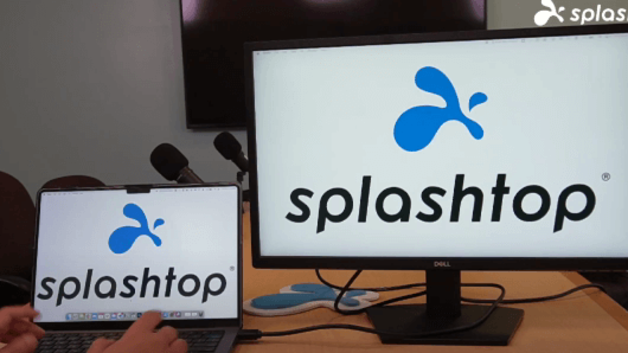Embracing the digital workspace revolution, dual-screen remote desktops are a transformative tool for enhancing work efficiency. This innovative approach expands the user's virtual desk across two monitors when accessing systems remotely. Such an arrangement is not just a luxury but a practical necessity in various professional scenarios. It allows for a broader visual canvas, crucial for multitasking and managing complex tasks that demand simultaneous access to different applications or documents.
Imagine the ease of comparing data on one screen while drafting a report on the other, or editing graphics with tools on one display and the artwork spread out on another. This dual-monitor setup transcends traditional single-screen limitations, fostering a more organized, less cluttered, and ultimately more productive work environment.
Discover in this article how to seamlessly transform your remote desktop experience into a dual-screen setup, enhancing productivity and efficiency in your remote work environment.
Is It Possible to Use Dual Monitors on a Remote Desktop?
Yes, it is absolutely possible to use dual monitors when connected to a remote desktop—provided both your remote desktop software and hardware setup support it. With the right configuration, you can either view both remote monitors on a single screen, switch between them, or extend them across your local dual-monitor setup.
This functionality is especially valuable for professionals who rely on multitasking, such as developers, designers, financial analysts, and IT administrators. Remote desktop solutions like Splashtop make it easy to work across multiple screens, replicating your in-office productivity from anywhere.
How Does It Work?
Using remote desktop software that supports dual screens, users can connect to a remote computer and extend the display across two or more monitors. This setup replicates the multi-monitor configuration of the local machine, providing a seamless experience as if the user is physically present at the remote computer.
Not all remote desktop applications support dual monitor setups. It is essential to choose software that explicitly offers this feature, such as Splashtop, which provides robust support for remote desktop multiple monitors.
By understanding and leveraging the advantages of a multiple-monitor remote desktop, users can significantly enhance their remote working experience, making it more productive and efficient.
Benefits of Dual Monitors in Remote Work
Using dual monitors while working remotely offers several advantages that help replicate the in-office experience and improve workflow across roles and industries.
1. Enhanced Productivity and Efficiency
Dual monitors allow you to work across multiple applications, documents, or tools without constant window switching. This leads to faster task completion and better multitasking.
2. Seamless Remote Working Experience
A dual-screen setup helps remote workers stay organized and maintain the same workspace layout they’re used to in the office, reducing friction and improving usability.
3. Flexibility and Mobility
Remote desktop solutions that support dual monitors let you access your full desktop layout from anywhere, whether you’re on a laptop with an external screen or switching between home and travel setups.
4. Consistency in Work Environment
Maintaining a familiar multi-monitor layout ensures consistency, helping users stay comfortable and focused while working across locations without adjusting to a different workflow.
5. Improved Focus and Organization
With two screens, it’s easier to separate tasks, such as keeping communication tools on one monitor and active work on the other, resulting in less distraction and more structured output.
Step-by-Step Guide to Configuring Dual Monitors with Splashtop Remote Desktop
Configuring a dual-monitor setup with Splashtop involves a straightforward process, ensuring that you get the most out of your remote desktop experience. Here's how to get started:

1. Ensure You Have the Latest Versions
Splashtop Streamer: This is the software installed on the remote computer (the one you want to access). Ensure that the latest version of Splashtop Streamer is installed on this machine. Regular updates often include improvements and new features, including enhanced multi-monitor support.
Splashtop Business App: This is the application used on the local computer (the one you are accessing from). Make sure that you have the latest version of the Splashtop Business App installed. Keeping this application updated is crucial for compatibility and access to the latest multi-monitor features.
2. Selecting the Display Mode
Once you have ensured that both the Streamer and Business App are up to date, you can choose how you want the monitors to be displayed during a remote session.
All Monitors (One-Window) Option: If you prefer to have all the remote monitors displayed in a single window on your local computer, select this option. This view is particularly useful when you need to have an overview of all the screens at once but are limited by a single monitor on your local device.
All Monitors (Multi-Window) Option: For those who have multiple monitors on their local device and wish to replicate the remote multi-monitor setup, this option allows each remote monitor to be displayed in a separate window. This setup is ideal for an immersive and extensive working environment, closely mimicking physically being in front of the remote desktop with multiple screens.
3. Accessing the Settings
The option to choose between "All Monitors (One-Window)" and "All Monitors (Multi-Window)" can typically be found in the settings or preferences section within the Splashtop Business App. Look for display or monitor options to adjust these settings.
By following these steps, you can efficiently set up and use a dual-monitor configuration with Splashtop, enhancing your productivity and replicating an in-office experience in a remote setting. This setup is particularly beneficial for professionals who rely on extensive screen space for their work, such as graphic designers, data analysts, and software developers.
Effortless Dual-Monitor Navigation with Splashtop's Keyboard Shortcuts
Splashtop's recent updates have introduced handy keyboard shortcuts, enhancing the ease and efficiency of controlling multiple monitors during a remote session. These shortcuts are particularly useful for quickly switching views between monitors without having to navigate through menus.
Key Shortcuts for Monitor Switching
Ctrl+Alt+#: This shortcut allows you to directly switch to a specific monitor. The "#" represents the number assigned to each monitor. For instance, Ctrl+Alt+1 would switch to the first monitor, Ctrl+Alt+2 to the second, and so on. This is an efficient way to quickly focus on a particular screen in a multi-monitor setup.
Ctrl+Alt+Right Arrow and Ctrl+Alt+Left Arrow: These shortcuts enable you to rotate through the monitors. The right arrow key moves you to the next monitor, while the left arrow key takes you to the previous one. This is particularly useful for navigating through multiple screens seamlessly.
These keyboard shortcuts are part of Splashtop's commitment to creating a more intuitive and efficient remote desktop experience. By enabling quick and easy monitor control, they greatly enhance productivity, especially in workflows that involve constant switching between different screens or applications.
For those frequently working with dual monitor setups in a remote desktop environment, mastering these shortcuts can significantly streamline their workflow. It's always a good idea to familiarize oneself with these shortcuts and practice using them to become more proficient in navigating dual monitors with ease.
Benefits of Dual Monitors in Remote Work
Dual monitor setups, especially when facilitated by remote desktop solutions like Splashtop, offer several advantages for remote work environments:
1. Enhanced Productivity and Efficiency
Expanded Workspace: Dual monitors effectively double the visual workspace, allowing users to open and view more applications simultaneously. This expanded view is particularly beneficial for tasks that require referencing multiple sources of information or using different software concurrently.
Reduced Window Switching: By having more screen space, users can avoid the frequent need to switch between windows or tabs. This not only speeds up the workflow but also reduces the cognitive load, making tasks less mentally taxing.
2. Seamless Remote Working Experience
Replicating Office Setup: For many professionals, working with multiple monitors is a standard part of their office setup. Splashtop's dual-monitor support allows them to replicate this environment at home or any remote location, ensuring a consistent and familiar working experience.
Versatility for Various Tasks: Whether used for data analysis, software development, graphic design, or financial modeling, dual monitors provide a more versatile platform for handling diverse tasks efficiently.
3. Flexibility and Mobility
Work from Anywhere: The ability to access a dual-monitor setup remotely means that professionals are not confined to a single location. They can maintain the same level of productivity whether they are at home, in a co-working space, or traveling.
Adaptable to Various Roles: Different roles require different workflows. A dual monitor setup, accessible remotely, offers the flexibility to adapt to these varying needs, making it an ideal solution for teams with diverse roles and responsibilities.
4. Consistency in Work Environment
Maintaining Workflow: Remote work can sometimes disrupt usual work routines. With dual monitors, professionals can maintain their workflow and organization, reducing the time needed to adapt to different work environments.
Customizable Setup: Users can arrange and organize their workspaces according to their preferences, just as they would in a physical office. This customization can lead to increased comfort and productivity.
Opt for Splashtop to Unleash the Full Potential of Dual Monitor Remote Desktop
In conclusion, when incorporated into remote work setups, dual monitors significantly enhance productivity, flexibility, and overall work satisfaction. These benefits are not just limited to a specific industry but extend across various fields, making dual monitors a valuable asset in the modern remote working landscape.
Eager to explore the benefits of a dual-monitor remote desktop setup? Experience it firsthand by signing up for a free trial with Splashtop.


